Header image from National Park Service.gov, City of Rocks National Reserve, Almo, Idaho
Idaho became the 43rd state on July 3, 1890
Mountain Bluebird
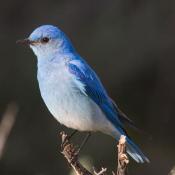
The different species of bluebirds are not very friendly with each other and even try to exclude the other species from their territories. This is especially true between Mountain Bluebirds and Western Bluebirds since they compete for the same nesting sites. Only the female bluebird builds the nest. The male sometimes acts as if he is helping, but he either brings no nest material or he drops it on the way. Many native Americans in the southwest see the mountain bluebird as a sacred symbol because of its azure-colored feathers. The Navajo regard it as the herald of the rising sun, the image of a god.
State bird of Idaho and Nevada
Flower: Syringa
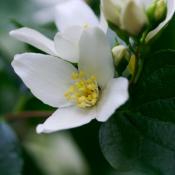
Syringa or mock orange was designated the official state flower of Idaho in 1931. Syringa (Philadelphus lewisii) is a woody shrub with clusters of white, fragrant flowers (sometimes called mock orange) that grows up to 10 feet tall. The species name (lewisii) honors Meriwether Lewis (of the Lewis & Clark expedition), who wrote about the plant in his journal. This species is found only in the western states of Montana, Wyoming, Washington, and California (however, similar flowers are found under different names throughout the northern hemisphere). Native Americans found many uses for syringa; the wood was used to make pipe stems, harpoon shafts, bows, arrows, root digging sticks, and snowshoes. The bark and leaves of syringa were used to make a soap.
Tree: Western White Pine
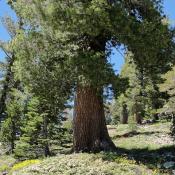
The western white pine tree grows in the mountains of the western United States and Canada (in the Sierra Nevada, the Cascade Range, the Coast Range, and the northern Rocky Mountains), extending down to sea level in many areas. Western white pine wood is soft, straight-grained, and evenly textured (used to make everything from houses to wooden matches).
State Quarter
From theus50.com
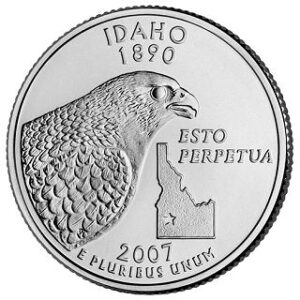
Idaho, nicknamed the “Gem State,” was admitted into the Union on July 3, 1890, becoming our Nation’s 43rd state. The reverse of Idaho’s quarter features the Peregrine Falcon imposing its presence above an outline of the State of Idaho. The coin bears the inscriptions “Esto Perpetua” (the State motto which means, “May it be Forever”).
The Peregrine Falcon is one of the fastest birds in the world. Once on the endangered species list, it can now be found throughout Idaho and the United States because of conservation efforts.
Capital: Boise
Nickname: Gem State
Motto: It is forever
Idaho Facts and Trivia
Forming part of the Pacific Northwest, Idaho is divided into several distinct geographic and climatic regions. The state’s north, the relatively isolated Idaho Panhandle, is closely linked with Eastern Washington with which it shares the Pacific Time Zone – the rest of the state uses the Mountain Time Zone. The state’s south includes the Snake River Plain (which has most of the population and agricultural land). The state’s south-east incorporates part of the Great Basin. Idaho is quite mountainous, and contains several stretches of the Rocky Mountains. The United States Forest Service holds about 38% of Idaho’s land, the most of any state.
Because of its remote location, Idaho was one of the last of the lower 48 U.S. states to be visited by Europeans.
In 1805, explorers Lewis and Clark entered Idaho on their way to the Pacific Ocean. They met with both the Shoshone and the Nez Perce peoples. Their guide was Sacagawea, a Shoshone Indian they had met in North Dakota.
Throughout the early 1800s more settlers came to Idaho. They included missionaries, fur traders, minors, and farmers. Many settlers traveled along the Oregon Trail which went through southern Idaho. Some settlers stopped along the way and made their home in Idaho. The first permanent settlement in Idaho was Franklin, which was established by the Mormons in 1860.
For many years, the region that included Idaho was claimed by both the United States and Britain. In 1846, the area officially became part of the United States through the Oregon Treaty with Britain. It joined the Oregon Territory in 1848. In 1853, Oregon became its own territory and Idaho became part of the Washington Territory. Idaho grew in population after gold was discovered in 1860 and, in 1863, became its own territory called Idaho Territory. It was many years later, on July 3, 1890, that Idaho joined the Union as the 43rd state.
Grangeville is located in north central Idaho. The community is considered the getaway to five wilderness areas and four national forests totaling 5 1/2 million acres. The total is second only to Alaska in designated wilderness area.
The Lewis & Clark Highway (United State Highway 12) is the shortest route from the midwest to the Pacific Coast and the longest highway within a national forest in the nation.
The Kamiah Valley is rich in the heritage and legends of the Nez Perce. It was here, among the ancestors of the present day Nez Perce, the Appaloosa horse was first bred, primarily for use as a war animal.
Hell’s Canyon is the deepest gorge in America.
Kuna is known as the Gateway City to the Birds of Prey Natural Area.
Birds of Prey Wildlife Area is home to the world’s most dense population of nesting eagles, hawks, and falcons.
President Theodore Roosevelt established the Caribou National Forest in 1907. The area now covers more than 1 million acres in southeast Idaho.
After the Civil War, many Midwestern and Southern Democrats moved to the Idaho Territory. As a result, the early territorial legislatures were solidly Democrat-controlled. In contrast, most of the territorial governors were appointed by Republican presidents and were Republicans. This led to sometimes-bitter clashes between the two parties, including a range war with the Democrats backing the sheepherders and the Republicans the cattlemen. That ended with the “Diamondfield” Jack Davis murder trial. In the 1880s, Republicans became more prominent in local politics.
In modern times, Idaho has been a reliably Republican state in presidential politics. It has not supported a Democrat for president since 1964. Even in that election, Lyndon Johnson defeated Barry Goldwater in the state by fewer than two percentage points, compared to a landslide nationally. In 2004, Republican George W. Bush carried Idaho by a margin of 38 percentage points and with 68.4% of the vote, winning in 43 of 44 counties. Only Blaine County, which contains the Sun Valley ski resort, supported John Kerry, who owns a home in the area. In 2016 Donald Trump won the election in Idaho with 59.2% of the vote. Hillary Clinton received 27.6% of the vote.
Strange Laws:
In Idaho law forbids a citizen to give another citizen a box of candy that weighs more than 50 pounds.
It is against the law to live in a dog kennel (or house) unless you’re a dog.
And don’t you dare think about riding a merry-go-round on a Sunday.
In Idaho Falls, it illegal to ride a motorcycle if you’re over 88.
Selling an “Idaho Deluxe” potato with rot, blemishes, or sun damage can get you sent to jail for up to six months.
The state of Idaho forbids you from fishing off the back of a camel or a giraffe.
People:
- Joe Albertson, grocery chain founder
- Gutzon Borglum, Mt. Rushmore sculptor
- Philo T Farnsworth, pioneered television technology
 Harmon Killebrew, baseball player
Harmon Killebrew, baseball player Sarah Palin, politician
Sarah Palin, politician- Aaron Paul, actor
- Ezra Pound, poet
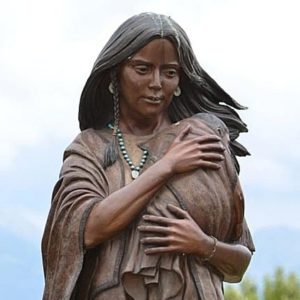 Sacagawea, Indian guide who traveled with Lewis and Clark
Sacagawea, Indian guide who traveled with Lewis and Clark Lana Turner, actress
Lana Turner, actress
Credits:
See ducksters.com
See 50 states.com
See only in your state.com
See Wikipedia
